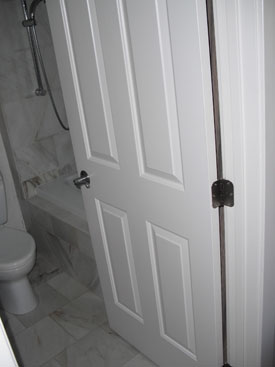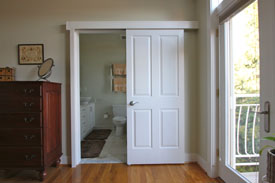Remodeling in Washington, DC can be tricky for many reasons; not the least of which is that you are frequently working with limited space. Particularly in multi-unit buildings, kitchens and bathrooms present design challenges as they are often confined to only a few square feet. When remodeling a kitchen, we are often able to increase the kitchen floor plan by removing a wall between an adjoining living or dining room to create an integrated space. Being that the space is shared; neither the kitchen nor adjoining room loses precious real estate.
Gaining space in bathrooms however, is more challenging. For obvious reasons, you can’t just open up a wall to share space with an adjoining room. Short of removing existing walls and re-framing the bathroom in a larger footprint, there is generally no quick fix to create a larger bathroom. Therefore, during bathroom remodels our designers are challenged to use every square foot in the most efficient manner. One strategy is to incorporate pocket doors into the design. Since the door actually slides back into the wall on a track, it does not obstruct space as a standard swinging door will. When installing a pocket door, it is generally necessary to reframe a section of the wall (to create the pocket in which the door is concealed) which then requires drywall, plaster and painting work.
An alternative, less costly solution is to install sliding doors, often referred to as “barn doors” or “sliders.” The hardware for these doors is either surface mounted on the wall above the door, or to the underside of the top of the door opening. Providing there is adequate support in the wall, it is not necessary to remove any wallboard or install additional framing. Such was the case during a recent bathroom update where the existing conventional door swung into the bathroom, blocking half of the bath tub when in the open position. The homeowners wanted to remove this obstacle without the hassle of ripping out existing framing and reworking the wallboard.
To accommodate their wishes, our design called for the sliding mechanism to be mounted on the outside of the wall. When ordering the door slab, we were careful to match the four-paneled doors installed throughout the rest of the house, and as a finishing touch, concealed the track and hardware with a decorative casing. As you can see below, the finished result was both functional and aesthetically pleasing.

